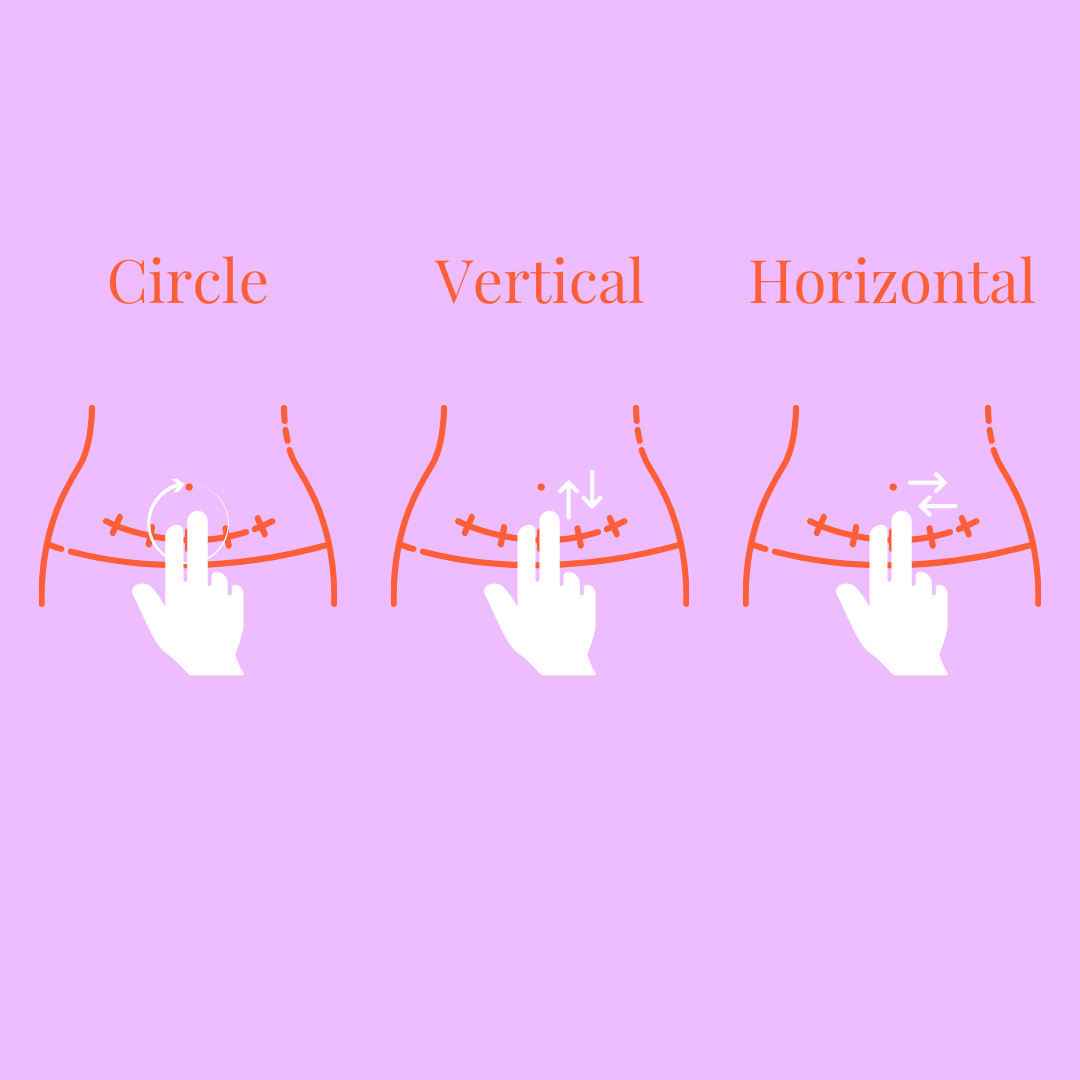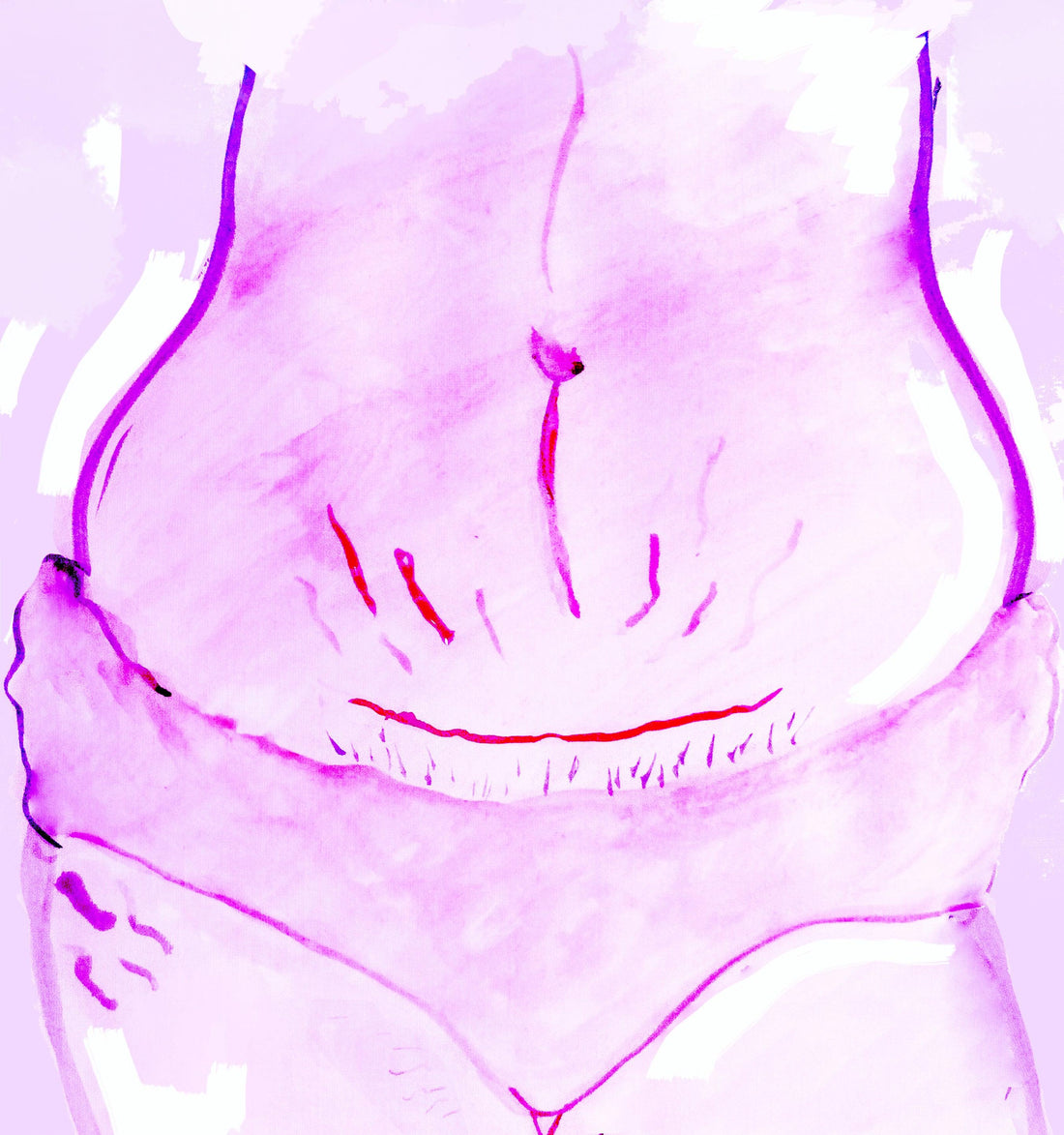-
Rub some of the Nessa Scar Savior balm on your hands (not too much as you will want to create a little bit of friction).
-
Start by rubbing the balm onto your belly to see how it feels, physically and emotionally. This might be the first time you’ve touched your stomach since birth, and it might feel like a lot. If this feels good, you can move towards the scar.
-
Now place the pads of your fingers on the edge of the scar.
-
We’ll start with a circular massage. Draw tiny circles around the area. Repeat 6-7 times.
-
Now we will massage the scar in a vertical pattern along the lining of the scar.
-
Finally in a horizontal fashion like a lightning bolt moving up and down the area.
How to care your for Caesarean scar from day one and beyond.
Birth, like parenthood, is unpredictable. Midwife, birth worker and author Jane Hardwicke Collins says, “We have the births that we need to have to teach us what we need to know about ourselves, to take us to the next place on our life journey, our journey to wholeness.”
In 2019, 36% of all women giving birth in Australia had their child via Caesarean section. The World Health Organization suggests that this rate should sit between 10% to 15%. A Caesarean section is a birth by which the baby is born through an incision. A cut is made in the birthing person's abdominal wall and uterus, through which the baby and placenta is pulled out. Six layers of tissue are made to get to that baby so it most certainly is not the easy way out. Whether your C-section birth was planned or via emergency, it left you feeling disheartened or empowered; the healing process is not linear, though there are some blanket rules.
In the first six weeks after birth, you are not to drive or lift anything heavier than your baby, you should avoid stairs (as much as you can, if you're in a two-storey house, obviously you'll be using them, but when you can, send someone else up to grab the nappies, and when there's an option, take the elevator), and should not insert anything into your vagina (not that you'd want to). If you’re feeling overwhelmed with “what’s next?” we've pieced together a roadmap for how best to care for your Caesarean wound and what to expect from day one, through to week six, and beyond. Remember that everyone's experience is unique and you should always consult your doctor, midwife or health professional for personalised recovery advice.
The day of your birth
After surgery you'll be moved, with your baby, to a post-op area so the doctors can check on your vitals and any bleeding you may have. If you've had an emergency You’ll have regular contact with your baby and can start trying to establish breastfeeding if you wish. The catheter will remain attached to you for at least 12 hours after surgery and your wound will remain covered for at least 24 hours. You’ll be encouraged to drink and eat (refuelling is essential and they'll want to check that all your bodily functions are working as they should) take pain medication (as required) and move gently and slowly around the bed. Your ability is going to be limited. You've just had major abdominal surgery, and there's a brand new baby in your arms. It can be a bit of an emotional rollercoaster. As the anaesthetic wears off you'll become more aware of pain and your legs will feel heavy. If you had general anaesthetic, you may feel sick or drowsy.
It's so important for your recovery that you take rest in this time. Accept and ask for help, you're just had major abdominal surgery.
The rest of your hospital stay
The average hospital stay post c-section is 4 days. Your abdomin will feel tight and you will walk with a bit of a stoop. That's normal. The nurses will be asking you if you need to poo yet and whether or not you've "passed wind" often as those things are a sign your body is working as normal. Your catheter will be removed and you'll wee in the toilet. Go you. If your C-section was emergency and you had begun to dialte, weeing might sting. Us the Bare Mum Perineal Wash Bottle to spray water at your vagina as you pee to take some of the sting away. Your IV will be disconnected next and you'll change to taking pain relief orally and be able to have a shower. Praise be. There's nothing quite like that first shower. It's normal to feel a bit anxious about getting your wound wet, by now you'll have steri-strips over the incision (which are water-safe) and trust us, it's entirely safe and good for it to be cleaned in the water. Don't scrub it, just let the soapy water run over it. Once out of the shower, you'll want some disposible postpartum pants. Postpartum bleeding occurs regardless of how your baby arrives, and it can be very heavy. During your hospital stay, ask the nurses all of your questions: breastfeeding, wound care, and how to safely get around. You need a lot of rest but movement helps your body stitch back together. One of the most important ones is knowing how to get out of bed. Roll to your side and push up with your arms (similar to how you would have been doing it in the last stages of your pregnancy). If you need to sneeze or laugh, use a towel to put some pressure on scar to support it.
The first days at home
On either your first or second midwife visit at home your dressing will be removed, exposing your wound so it can scab and heal. Like all open wounds, it’s best to keep it clean without overly irritating the area (so no soaps or touching) and you’ll need to give it open-air time (to dry out). Again, you can use the Bare Mum Perineal Wash Bottle to target water to and clean your scar without excess pressure. Wear comfortable, soft cotton high-waisted underwear. Think undies by Juem and Modibodi, as they are cotton, loose-fitting and allow for some breathing space. Healthcare providers normally suggest you take paracetamol or ibuprofen in tandem to keep on top of the pain (safe for breastfeeding) and limit movement where possible. Keeping your midline warm is also so essential for recovery. Warmth helps to promote blood flow and fresh oxygenation to the area. You may want to try the ModiBodi Postpartum Control Brief, SRC Recovery Shorts or the 3-in-1 Pregnancy, Postpartum & C-Section Original Belly Band to support your muscles coming back together.
Week 2
You're most likely feeling a world of different to what you were a week ago. It is incredible how quickly your mobility improves. It's still really important to take it easy, accept and ask for help. Eat nutritious food, rest and do what feels good to you. If you're still having cramps, you can use a hot waterbottle, just don't put it on your scar, and be on the watch for the following symptoms: severe pain, leaking urine, pain when peeing, increasingly heavy vaginal bleeding, wound irritation or pain, pus or smelly dischard from your wound, lower leg pain, a cough or shortness of breath. If any symptoms present, contact your midwife, doctor or hospital.
Week 3 to 6
Now that your scab is healing, the most important thing is to get your nerves working again. Nerves are damaged through the multiple layers of incision, so it’s essential to re-stimulate them and get them firing once again. You can start by using different textures above the scar. Use a combination of surfaces, for example, a makeup brush, cotton balls or cotton tips and make circles, gliding movements and squiggles with your props. You'll be able to take slightly longer walks, and do more around the house and in the care of your baby, but remember to listen to your body.
Week 6 and beyond
Once you have been given the green light from your 6-week appointment with your health care provider and the wound is fully healed, massage can do wonders for your recovery. Mentally it can aid in the reconnection with your body, help with numbness and increased sensitivity and reduce pain and restriction in the area. Gently massaging your abdomen increases blood flow and circulation, which supports the healing process by breaking up the layers of scar tissue beneath. The Nessa Scar Saviour is a great cream to do this whilst simultaneously minimising the appearance of your scars using anti-inflammatory and antioxidant ingredients.
How to Massage Your C-Section Scar























